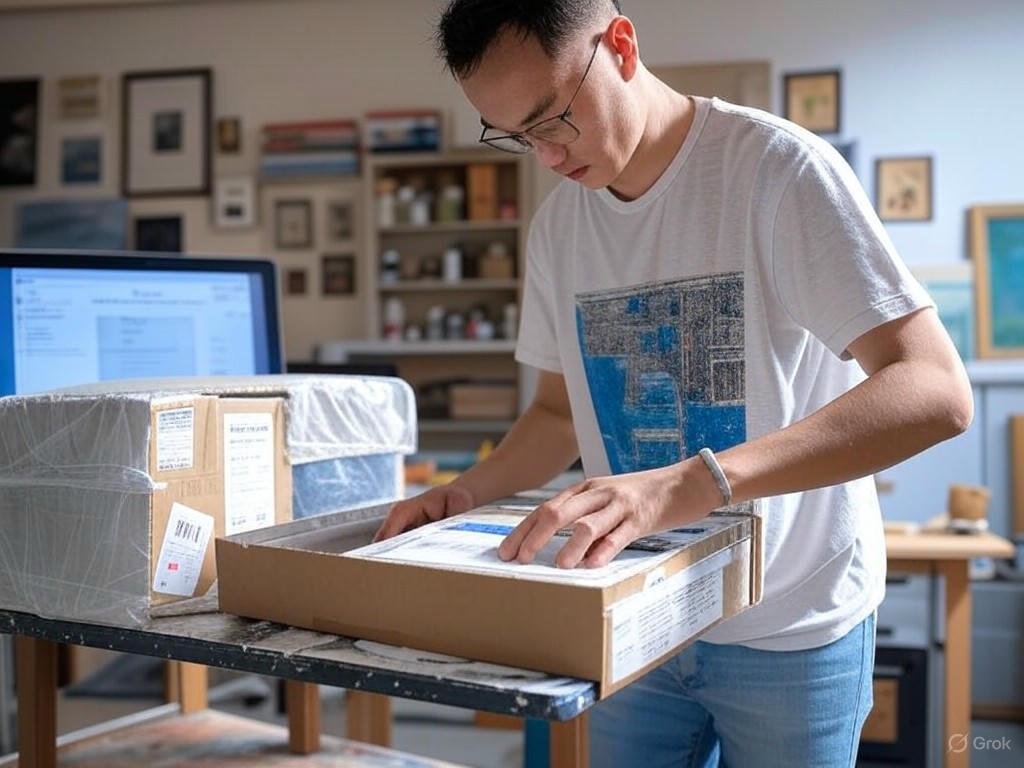Selling art online is a dream for many artists. The idea of turning your passion into a thriving business, reaching collectors across the globe, and making a living from your creativity is exhilarating. But let’s be real—it’s also intimidating. When I first started exploring how to sell art online and make money, I was overwhelmed by the endless platforms, marketing strategies, and technical details. I doubted whether my work was good enough or if I could stand out in a sea of talented artists. Spoiler alert: I made it work, and you can too.
This guide is my love letter to every artist who’s ever wondered, “Can I really make money selling my art online?” It’s packed with practical tips, personal anecdotes, and hard-earned lessons from my journey. Whether you’re a painter, illustrator, photographer, or sculptor, I’ll walk you through the steps to build an online art business that’s authentic, profitable, and sustainable. Let’s dive in.
Why Selling Art Online Is a Game-Changer

The internet has revolutionized how artists connect with buyers. Gone are the days when you needed a gallery to showcase your work or a fancy art fair to make sales. Today, platforms like Etsy, Instagram, and Shopify let you reach millions of potential customers from your living room. But the real magic? You’re in control. You decide how to present your art, set your prices, and tell your story.
When I sold my first painting online—a vibrant acrylic piece inspired by a sunset hike—I felt a rush like no other. The buyer, a woman from Seattle, messaged me to say how the colors brightened her home. That moment wasn’t just about the money (though the $200 was nice!). It was about knowing my art had a place in someone’s life. Selling art online isn’t just a transaction; it’s a connection.
But let’s not sugarcoat it—success doesn’t happen overnight. It takes strategy, persistence, and a willingness to learn. Below, I’ll break down the key steps to help you sell your art online and make money, with tips I wish I’d known when I started.
Step 1: Create Art That Speaks to Your Audience
Before you even think about platforms or pricing, focus on your art itself. What makes your work unique? What story are you telling? Your art is your brand, and it needs to resonate with the people you want to reach.
When I began, I was all over the place—painting abstracts one day, sketching portraits the next. My portfolio looked like a chaotic scrapbook. It wasn’t until I honed in on my love for nature-inspired abstracts that I started attracting consistent buyers. People connected with the emotion behind my work, and that’s what sold.
Tips for Creating Marketable Art
Find Your Niche: Experiment to discover what you love creating, but narrow it down to a cohesive style or theme. Are you drawn to bold watercolors, minimalist line art, or quirky digital illustrations? A focused portfolio helps buyers recognize your brand.
Know Your Audience: Who’s likely to buy your art? Young professionals decorating their first apartments? Families looking for nursery prints? Art collectors seeking statement pieces? Tailor your work to their tastes without losing your authenticity.
Quality Matters: Invest in good materials and refine your technique. Buyers can tell when art is made with care, and they’re willing to pay for it.
Don’t be afraid to let your personality shine through. My best-selling pieces are the ones that feel deeply personal—like a canvas I painted after a tough breakup, full of stormy blues and fiery reds. People don’t just buy art; they buy the story behind it.
Read more: Viral Pages AI Review – A Comprehensive Insight Analysis
Step 2: Build a Stunning Online Portfolio

Your online portfolio is your virtual gallery. It’s where potential buyers get their first impression of your work, so it needs to be professional, easy to navigate, and visually captivating.
I learned this the hard way. My first “portfolio” was a clunky WordPress site with pixelated images and a confusing layout. I got zero inquiries. After revamping it with high-quality photos and a clean design, inquiries started rolling in within weeks.
How to Create a Killer Portfolio
Choose the Right Platform: Websites like Squarespace, Wix, or WordPress offer artist-friendly templates. If you’re on a budget, platforms like Behance or Instagram can double as your portfolio.
Showcase Your Best Work: Curate your portfolio to highlight 10-20 of your strongest pieces. Quality over quantity.
Optimize for Mobile: Most buyers browse on their phones, so ensure your site is mobile-friendly.
Include an About Page: Share your story, inspirations, and process. Buyers love knowing the person behind the art. My About page, where I talk about painting in my tiny apartment surrounded by plants, gets more comments than any other page on my site.
Add Contact Info: Make it easy for buyers to reach you with a clear contact form or email address.
Pro tip: Use high-resolution images and include close-up shots to show texture and detail. For example, my textured acrylics look flat in low-res photos, but zoomed-in shots of the brushstrokes make them pop.
Step 3: Choose the Right Platforms to Sell Your Art
Deciding where to sell your art online can feel like choosing a college major—there are so many options, and each has pros and cons. Here’s a breakdown of the most popular platforms, based on my experience and research.
Top Platforms for Selling Art Online
Etsy: Perfect for prints, small originals, and handmade goods. It’s beginner-friendly, with a built-in audience of art lovers. I sold my first print on Etsy within a month of setting up shop. The downside? Fees can add up, and competition is fierce.
Shopify: Ideal if you want full control over your brand. It’s great for selling originals, prints, and merch like tote bags. Setup takes more effort, but the customization is worth it.
Redbubble or Society6: These print-on-demand sites handle production and shipping, so you just upload your designs. They’re low-effort but take a big cut of your profits. I use Redbubble for my digital art, and it’s a nice passive income stream.
Instagram: Not a traditional e-commerce platform, but it’s a powerhouse for artists. Use Instagram Shop or link to your website. My DMs are full of inquiries from followers who found me through hashtags like #ArtForSale.
Saatchi Art: Best for high-end originals aimed at collectors. It’s selective, so your work needs to stand out, but the exposure is unmatched.
When I started, I spread myself thin across too many platforms. Now, I focus on Etsy for prints, Shopify for originals, and Instagram for promotion. Experiment to find what works for you, but don’t overcommit—maintaining multiple shops is exhausting.
Read more: AI Interactive Books Review: A Game-Changer for Content Creators
Step 4: Price Your Art Fairly (and Confidently)
Pricing is where many artists (myself included) get stuck. You don’t want to undervalue your work, but you also don’t want to scare buyers away. Early on, I priced a 16×20 painting at $50 because I was terrified no one would buy it. Spoiler: It sold in hours, and I kicked myself for not charging more.
How to Price Your Art
Consider Your Costs: Factor in materials, time, and platform fees. For example, a painting that takes 10 hours at $20/hour, plus $30 in supplies, should be priced at least $230 to break even.
Research the Market: Look at what similar artists charge on Etsy or Saatchi Art. A beginner might price prints at $20-$50 and originals at $100-$500, while established artists can charge thousands.
Account for Perceived Value: Buyers often equate price with quality. A $300 painting feels more “legit” than a $30 one, even if the work is similar.
Offer Tiered Options: Sell prints, small originals, and large statement pieces to appeal to different budgets. My $25 prints outsell my $500 originals, but both keep my income steady.
Don’t be afraid to raise your prices as you gain experience. After my first few sales, I bumped my prices by 20%, and buyers didn’t blink. Confidence is key.
Step 5: Market Your Art Like a Pro
Marketing is where the magic happens. You could have the most beautiful art in the world, but if no one sees it, you won’t make a dime. Marketing used to intimidate me—I’m an artist, not a salesperson! But once I embraced it, my sales skyrocketed.
Effective Marketing Strategies
Leverage Social Media: Instagram and Pinterest are goldmines for artists. Post consistently, use hashtags like #SellArtOnline, #ArtForSale, and #ArtistOnInstagram, and engage with followers. My follower count doubled after I started posting behind-the-scenes videos of my painting process.
Build an Email List: Collect emails through your website or at art shows. Send monthly newsletters with new releases, discounts, or personal stories. My email list is small (about 500 subscribers), but it drives 30% of my sales.
Collaborate with Influencers: Partner with bloggers or micro-influencers who share your aesthetic. A local lifestyle blogger featured my prints, and I got 10 orders that week.
Run Promotions: Offer limited-time discounts or bundle deals. For example, I ran a “Buy 2 Prints, Get 1 Free” sale during the holidays, and it cleared out my inventory.
The key to marketing is authenticity. Don’t just sell—share your journey. When I posted about struggling with self-doubt as an artist, the response was overwhelming. People bought my work because they connected with my vulnerability.
Read more: Online Surveys That Pay Cash – A Proven Method for Earning Money
Step 6: Master the Art of Customer Service
Selling art online isn’t just about the sale—it’s about creating a memorable experience for your buyers. Great customer service turns one-time buyers into loyal collectors.
I once had a buyer whose package arrived damaged due to a shipping mishap. I was mortified, but I promptly sent a replacement and included a handwritten note with a small print as an apology. She’s now one of my best customers and refers friends to my shop.
Customer Service Tips
Communicate Clearly: Respond to inquiries within 24 hours and provide tracking info for shipments.
Package with Care: Use sturdy materials to protect your art. I wrap prints in tissue paper and include a thank-you card—it’s a small touch that buyers love.
Handle Issues Gracefully: If something goes wrong, offer refunds or replacements quickly. It’s better to lose a little money than your reputation.
Follow Up: Send a thank-you email after a purchase and ask for feedback. It builds trust and encourages reviews.
Step 7: Diversify Your Income Streams
Relying solely on original paintings or prints can be risky. To make consistent money selling art online, diversify your offerings. This was a game-changer for me. When I started offering digital downloads and art-themed merch, my income became more stable.
Ideas for Diversifying
Digital Downloads: Sell printable art for buyers to download and print at home. They’re low-cost to create and have high profit margins.
Merchandise: Use print-on-demand services to sell your art on mugs, phone cases, or apparel. My Redbubble shop earns $100-$200 a month with zero effort.
Workshops or Tutorials: Teach online classes or create YouTube tutorials. I hosted a $50 virtual watercolor workshop and made $500 in one evening.
Commissions: Offer custom pieces for clients. Commissions are time-intensive but can be lucrative.
Diversifying doesn’t mean diluting your brand. Choose products that align with your art and audience. My nature-inspired designs look great on tote bags, but I wouldn’t put them on tech gadgets—it just doesn’t fit.
Step 8: Stay Consistent and Keep Learning
Selling art online is a marathon, not a sprint. There will be slow months, algorithm changes, and moments of self-doubt. But consistency and a willingness to adapt will carry you far.
I used to panic when sales dipped, thinking I’d failed. Now, I see slow periods as opportunities to experiment—maybe try a new platform, refresh my portfolio, or learn about SEO. Every time I push through, I come out stronger.
Tips for Long-Term Success
Set Goals: Aim for a certain number of sales, followers, or new pieces each month. Small, achievable goals keep you motivated.
Track Your Progress: Use a spreadsheet to monitor sales, expenses, and marketing efforts. It helps you spot what’s working.
Stay Inspired: Follow other artists, take online courses, or visit galleries to keep your creativity flowing.
Learn About SEO: Optimize your listings and website with keywords like “how to sell art online,” “buy art online,” or “original paintings for sale.” It’s how buyers find you on Google or Etsy.
My Biggest Lesson: Believe in Your Worth
If there’s one thing I’ve learned, it’s this: Your art is worth it. You are worth it. When I started, I was so focused on “making it” that I forgot to enjoy the process. Now, every sale—whether it’s a $20 print or a $1,000 commission—feels like a celebration of my growth.
Selling art online and making money isn’t just about strategy; it’s about trusting your voice and sharing it with the world. You don’t need a fancy degree or a huge following. You need passion, persistence, and a willingness to put yourself out there.
So, go create that portfolio, list your first piece, and tell your story. The world is waiting to fall in love with your art. And who knows? Your next sale might be the one that changes everything.






